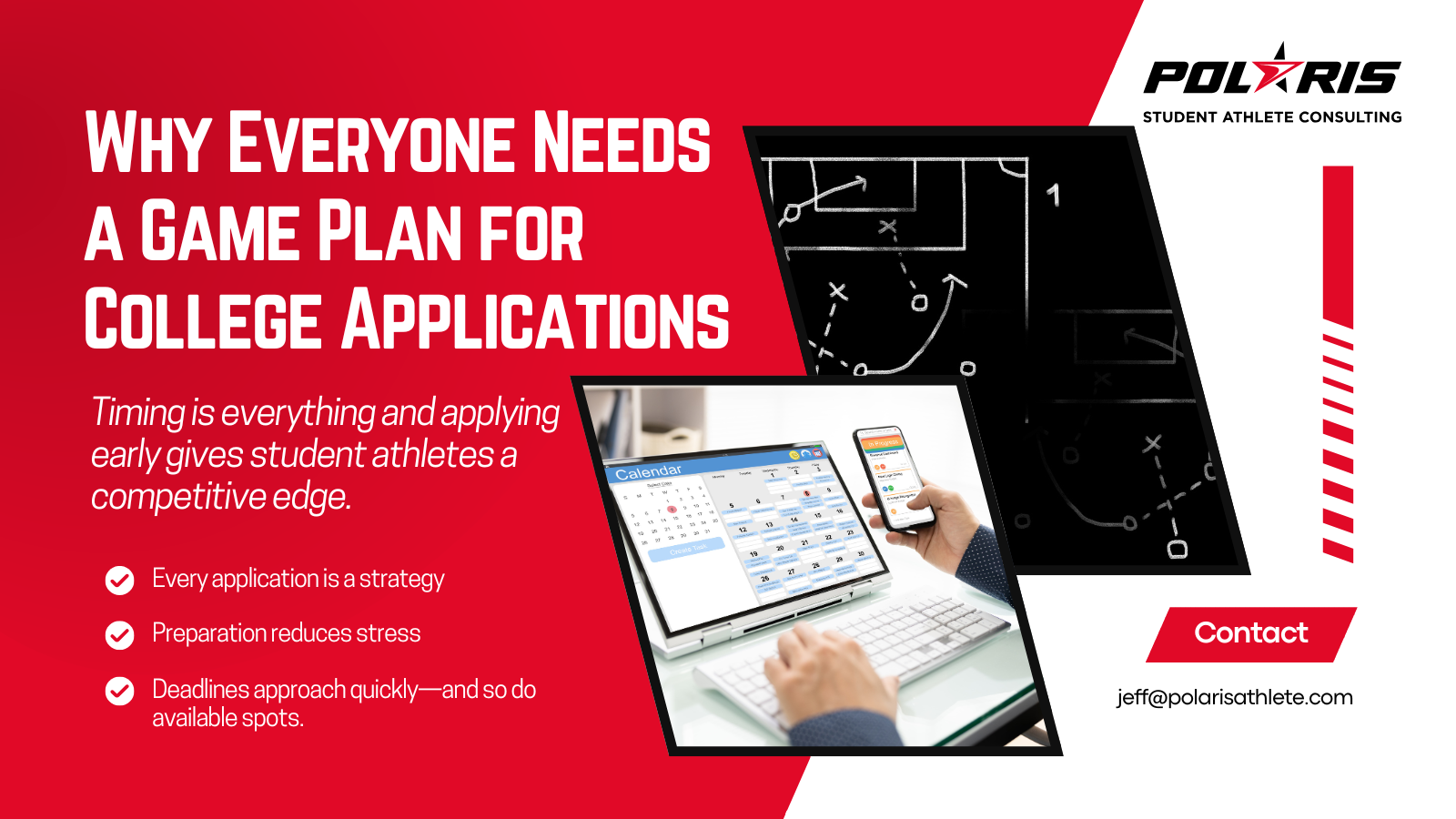Why Everyone Needs a Game Plan for College Applications
At POLARIS Student Athlete Consulting, we work with student athletes and their families every day to create strategies that align not just with where students want to go—but how and when they apply. Applying early shows coaches and potential NIL partners that you're focused, dependable, and ready to lead. It signals initiative, maturity, and brand-readiness, all qualities that make you stand out.
In today’s admissions landscape, it’s no longer enough to just hit “submit” before the final deadline. Colleges are building their classes early, and students who wait until January may already be applying to a class that’s nearly full—especially at popular public universities. With increasing demand and limited capacity in certain programs, timing has become a critical part of a successful admissions game plan.
Why Early Matters More Than Ever
Many colleges now fill a large percentage of their incoming class through Early Action (EA), Early Decision (ED), or Priority deadlines. Submitting your application early doesn’t just demonstrate organization—it shows interest, and that matters. Admissions officers are looking for students who are proactive, prepared, and serious about attending their institution. Early applications send that message loud and clear.
This is especially true for student athletes. If you're not committing to a school athletically but still hope to be recruited, walk on, or join a competitive academic program, applying early can position you for stronger consideration. In many cases, limited seats in high-demand majors (like business, nursing, or engineering) mean that once a department hits capacity, even top applicants can be shut out—not for lack of qualifications, but simply due to space.
Real Talk: What Penn State Can Teach Us
Take Penn State, for example. Their Early Action deadline is November 1, and any applications submitted after that are reviewed on a rolling basis. That sounds flexible, but there’s a catch. Penn State receives a massive volume of applications, and the most competitive programs fill quickly. If you wait too long, you’re likely competing for fewer spots in a much more crowded pool.
Rolling admission may feel forgiving, but in practice, it rewards early movers. Submitting by the early deadline can significantly improve your chances, especially for specific campuses or majors like University Park or Smeal College of Business.
Build Your Admissions Game Plan
So, what can student-athletes do to stay ahead?
Know your deadlines. Identify which schools on your list offer EA, ED, Priority, or Rolling Admission.
Work backward from those deadlines. Allow time for essays, test scores, transcripts, and recommendations to come together.
Coordinate with your recruiting calendar. Make sure your application timeline supports ongoing conversations with coaches—even if you’re not committing athletically.
Talk about finances early. If you're considering ED, understand what it means financially for your family.
In a college admissions world that’s more competitive than ever, timing is a strategy and student athletes who apply early give themselves a powerful edge. Whether you’re planning to play at the next level or simply want to maximize your options, starting early means showing schools you’re prepared, intentional, and ready to succeed.
Types of College Admissions Applications (With Examples):
1. Open Admission
📅 Deadline: Varies
✅ Binding? No
💡 Best for: Students seeking open access to higher education. Admission is typically guaranteed with a high school diploma or equivalent.
2. Rolling Admission
📅 Deadline: Applications reviewed as they’re received
📨 Notification Example: Typically 2–6 weeks after applying
✅ Binding? No
💡 Best for: Students who want flexibility and a quicker response
3. Regular Decision (RD)
📅 Deadline Example: January 15
📨 Notification: End of March
✅ Binding? No
💡 Best for: Students who want time to finalize applications and compare offers
4. Priority Deadline
📅 Deadline Example: November 1 (priority), December 1 (final)
💡 Why it matters: Students who apply by the priority deadline are considered for honors programs, scholarships, and more competitive majors
5. Early Action (EA)
📅 Deadline Example: November 1
📨 Notification Example: Late December
✅ Binding? No
💡 Best for: Students ready to apply early but not ready to commit
6. Restrictive Early Action (REA) / Single-Choice Early Action (SCEA)
📅 Deadline Example: November 1
📨 Notification Example: Mid-December
✅ Binding? No
🚫 Restriction: You cannot apply early to other private colleges
💡 Best for: Students with a clear first-choice school who want early results but flexibility in financial aid comparison
7. Early Decision (ED)
📅 Deadline Example: November 1 (ED I), January 1 (ED II)
📨 Notification Example: December (ED I), February (ED II)
✅ Binding? Yes
💡 Best for: Students 100% committed to attending if admitted
*Actionable Advice for Student Athletes
Applying early doesn’t just benefit your admissions chances. It also sends a strong message to college athletic coaches and potential NIL partners. It shows that you’re organized, serious about your goals, and prepared to compete in all facets. Coaches value student athletes who take initiative and meet deadlines, and early action can position you as a reliable recruit. For NIL opportunities, it signals maturity, commitment, and brand-readiness. All qualities that sponsors and organizations look for when aligning with athletes who represent their values.

